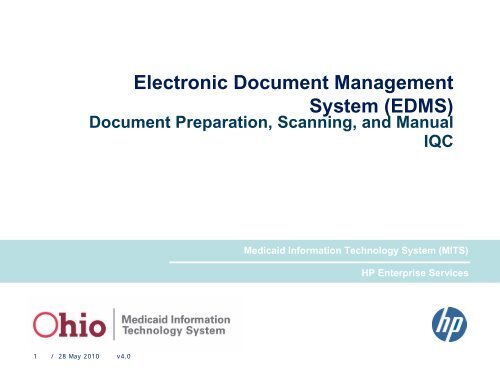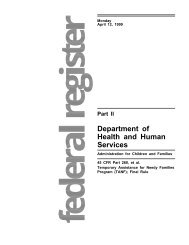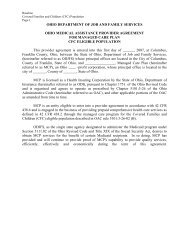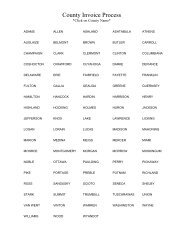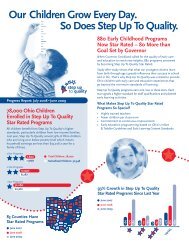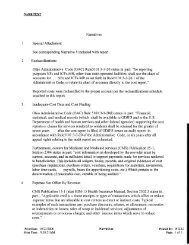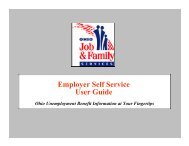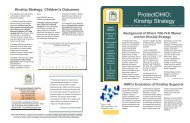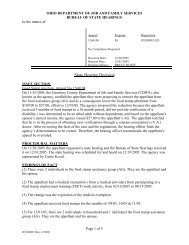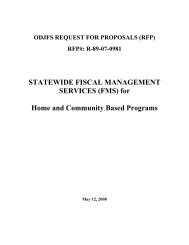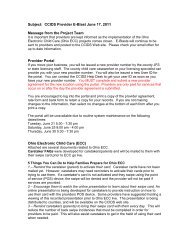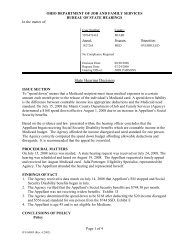Electronic Document Management System
Electronic Document Management System
Electronic Document Management System
Create successful ePaper yourself
Turn your PDF publications into a flip-book with our unique Google optimized e-Paper software.
1 / 28 May 2010 v4.0<br />
<strong>Electronic</strong> <strong>Document</strong> <strong>Management</strong><br />
<strong>System</strong> (EDMS)<br />
Insert Subtitle Here<br />
<strong>Document</strong> Preparation, Scanning, and Manual<br />
IQC<br />
Medicaid Information Technology <strong>System</strong> (MITS)<br />
HP Enterprise Services
EDMS Catalog of Courses<br />
Introduction to EDMS<br />
Business Courses<br />
<strong>Document</strong> Preparation, Scanning, and Manual IQC<br />
Correction Processing – Completion: NEW<br />
Quality Assurance – Completion: VERIFY<br />
FileNet One Step Workflow<br />
COLD Reports<br />
Technical Courses<br />
Orientation to FileNet <strong>System</strong> Administration<br />
Orientation to Captiva <strong>System</strong> Administration<br />
2 / 28 May 2010 v4.0 EDMS – <strong>Document</strong> Preparation, Scanning, and Manual IQC
EDMS: <strong>Document</strong> Preparation, Scanning,<br />
and Manual IQC<br />
Course Objectives<br />
1. Explain the need for scanning documents into<br />
EDMS<br />
2. Describe the objective and the activities of each step<br />
of the scanning process in detail, including:<br />
a) The types of inbound documents to be scanned<br />
b) Sorting and batching the documents in<br />
preparation for scanning<br />
c) The scanning process itself<br />
d) Disposition of the paper documents after<br />
scanning<br />
3 / 28 May 2010 v4.0 EDMS – <strong>Document</strong> Preparation, Scanning, and Manual IQC
Agenda<br />
1. Introduction<br />
2. Background – What is Being Scanned?<br />
3. <strong>Document</strong> Preparation<br />
4. Scanning<br />
5. Manual IQC<br />
4 / 28 May 2010 v4.0 EDMS – <strong>Document</strong> Preparation, Scanning, and Manual IQC
Introduction
EDMS Related Definitions<br />
Term Definition<br />
Captiva Commercial off-the-shelf (COTS) software that manages the<br />
scanner, from interpreting the scanned documents through<br />
storing the resulting images on the FileNet data repository with<br />
index values. Captiva can be programmed to recognize certain<br />
documents (such as claim forms).<br />
Coversheet EDMS’ predefined sheet that must precede certain documents to<br />
be scanned, for identifying the document and its index/key value.<br />
FileNet The database in which EDMS stores all MITS application data<br />
received for storage.<br />
IQC Image quality control is the process used by Captiva to<br />
automatically detect image quality issues such as dog ears,<br />
image darkness, etc.<br />
OCR Optical character recognition, which is the Captiva software’s<br />
ability to ‘read’ black typed data off red forms and eliminate the<br />
need for data entry.<br />
6 / 28 May 2010 v4.0 EDMS – <strong>Document</strong> Preparation, Scanning, and Manual IQC
EDMS – A Bird’s Eye View …<br />
7 / 28 May 2010 v4.0 EDMS – <strong>Document</strong> Preparation, Scanning, and Manual IQC
What Information Does EDMS Store?<br />
A.<br />
Images of scanned documents<br />
With Go-Live, four types of documents will<br />
be scanned:<br />
1. Claims (CMS1500, UB04, ADA2006) – only<br />
those with attachments<br />
2. Claims adjustments (6766, 6767, 6768)<br />
3. Proprietary forms (9400, 9401, 9402, 9405)<br />
4. Paper attachments sent by the provider to<br />
support Claims, Provider Enrollments (PE),<br />
and Prior Authorizations (PA) that the<br />
provider uploaded via the Web Portal<br />
8 / 28 May 2010 v4.0 EDMS – <strong>Document</strong> Preparation, Scanning, and Manual IQC
What Information Does EDMS Store?<br />
B. <strong>Document</strong>s that will be directly loaded into<br />
EDMS – not from scanning:<br />
1. Provider enrollment (PE) attachments and prior<br />
authorization (PA) attachments that were<br />
uploaded by providers on the Web Portal and<br />
stored directly into EDMS<br />
2. COLD reports (standard business reports)<br />
created by the interChange applications<br />
3. Outbound letters and forms generated by MITS<br />
and/or the business user, via the Letter<br />
Generator process<br />
9 / 28 May 2010 v4.0 EDMS – <strong>Document</strong> Preparation, Scanning, and Manual IQC
Background<br />
What Is Being Scanned?
Agenda<br />
1. Introduction<br />
2. Background – What is Being Scanned?<br />
a) Claims (CMS1500, UB04, ADA2006) – only<br />
those with attachments<br />
b) Claim adjustment forms (6766. 6767. 6768)<br />
c) Proprietary forms (9400, 9401, 9402, 9405)<br />
d) Paper attachments sent by providers<br />
3. <strong>Document</strong> Preparation<br />
4. Scanning<br />
5. Manual IQC<br />
11 / 28 May 2010 v4.0 EDMS – <strong>Document</strong> Preparation, Scanning, and Manual IQC
Background: What is Being Scanned<br />
What is the goal of scanning?<br />
• To create electronic images of paper documents<br />
related to Claims, Claim Adjustments, PE requests,<br />
PA requests, and other OHP related ‘transactions’<br />
How do these documents come into OHP?<br />
• Providers and other entities are instructed to mail them<br />
to unique PO boxes, based on document type<br />
• Being separated by mailbox simplifies the process of<br />
sorting the documents into the correct batches for<br />
scanning<br />
12 / 28 May 2010 v4.0 EDMS – <strong>Document</strong> Preparation, Scanning, and Manual IQC
Background: What is Being Scanned<br />
Those documents to be scanned for storage<br />
within EDMS:<br />
1. Claims (CMS1500, UB04, ADA2006) – only<br />
those with attachments<br />
2. Claims adjustments (6766, 6767, 6768)<br />
3. Proprietary forms (9400, 9401, 9402, 9405)<br />
4. Paper attachments sent by the provider to<br />
support Claims, Provider Enrollments (PE),<br />
and Prior Authorizations (PA) that the<br />
provider already uploaded via the Web Portal<br />
13 / 28 May 2010 v4.0 EDMS – <strong>Document</strong> Preparation, Scanning, and Manual IQC
Background: What is Being Scanned<br />
1. Claims – only with attachments<br />
There are three types of claims:<br />
A. CMS1500 – Health Insurance Claim form<br />
B. UB04 – Institutional Claims form<br />
C. ADA2006 – Dental Claim form<br />
Optical character recognition (OCR) reads the key<br />
information off the red claim forms. Captiva is<br />
programmed to find the key fields on each red form.<br />
For black forms, data entry (‘Key From Image’, or KFI)<br />
will manually capture key information.<br />
14 / 28 May 2010 v4.0 EDMS – <strong>Document</strong> Preparation, Scanning, and Manual IQC
Background: What is Being Scanned<br />
Examples of RED and BLACK claim forms<br />
15 / 28 May 2010 v4.0 EDMS – <strong>Document</strong> Preparation, Scanning, and Manual IQC
Background: What is Being Scanned<br />
2. Claim adjustment forms (6766, 6767, 6768)<br />
3. Proprietary forms (9400, 9401, 9402, 9405)<br />
• All of the above forms relate to claims that are<br />
already in the system.<br />
• Therefore, they should come in as a ‘stand-alone’,<br />
i.e., not attached to a claim.<br />
• They will have attachments themselves (all but<br />
the 6768).<br />
16 / 28 May 2010 v4.0 EDMS – <strong>Document</strong> Preparation, Scanning, and Manual IQC
Background: What is Being Scanned<br />
4. Paper attachments sent by providers<br />
• These are attachments sent by the provider to<br />
support claims, provider enrollments (PE), and<br />
prior authorizations (PA) that the provider<br />
uploaded via the Web Portal.<br />
• The provider did not have these in electronic<br />
format to upload along with the claim, PE, or PA.<br />
• The Portal gave instructions to the provider to<br />
mail these attachments in to OHP, to a specific<br />
mailbox. That is how they get to EDMS for<br />
scanning.<br />
17 / 28 May 2010 v4.0 EDMS – <strong>Document</strong> Preparation, Scanning, and Manual IQC
Background: What is Being Scanned<br />
Possible types of Claim attachments:<br />
1. COB (Coordination of Benefits) and/or OI (Other<br />
Insurance) forms – these forms replace Medicaid<br />
form 6780, which will no longer be accepted as of<br />
Go Live *<br />
Special Note: The COB and OI forms are discussed in this training<br />
but may not be scanned as of Go Live, pending a JFS decision to<br />
limit these forms to portal upload only.<br />
* COB/OI forms should not be mailed in without a claim;<br />
if they are, they will be returned to the provider.<br />
18 / 28 May 2010 v4.0 EDMS – <strong>Document</strong> Preparation, Scanning, and Manual IQC
Background: What is Being Scanned<br />
More Possible types of Claim attachments:<br />
2. 6653 forms (for claims over 365 days old) *<br />
3. HAS forms (Hysterectomy, Abortion, and<br />
Sterilization consent forms) *<br />
4. Any other documents that may accompany a claim<br />
* 6653 and HAS forms should not be mailed in without a<br />
claim.<br />
19 / 28 May 2010 v4.0 EDMS – <strong>Document</strong> Preparation, Scanning, and Manual IQC
Background: What is Being Scanned<br />
Q: What about claims with no attachments?<br />
A: Possitivity will continue to scan ‘clean’ claims after<br />
Go-Live – claims with no attachments.<br />
• Possitivity will send the images to OHP where<br />
users can view them on existing CISS image<br />
viewers.<br />
• They will also send specific claim data via EDI<br />
to interChange for processing and viewing.<br />
• No information from those ‘clean’ claims will be<br />
stored on EDMS.<br />
20 / 28 May 2010 v4.0 EDMS – <strong>Document</strong> Preparation, Scanning, and Manual IQC
Background: What is Being Scanned<br />
These must<br />
accompany a<br />
claim, as<br />
attachments,<br />
when received:<br />
If received with<br />
a claim, the<br />
claim must be<br />
an attachment<br />
to these forms:<br />
• COB and/or OI forms<br />
• 6653 forms (claims > 365 days old)<br />
• HAS forms (Hysterectomy,<br />
Abortion, and Sterilization consent<br />
forms)<br />
• Claims Adjustment forms<br />
(6766, 6767, 6768)<br />
• Proprietary forms<br />
(9400, 9401, 9402, 9405)<br />
21 / 28 May 2010 v4.0 EDMS – <strong>Document</strong> Preparation, Scanning, and Manual IQC
<strong>Document</strong> Preparation:<br />
Inbound <strong>Document</strong>s and Mailboxes<br />
Sorting and Batching
Agenda<br />
1. Introduction<br />
2. Background – What is Being Scanned?<br />
3. <strong>Document</strong> Preparation<br />
a) Inbound <strong>Document</strong>s and Mailboxes<br />
b) Sorting and Batching <strong>Document</strong>s for<br />
Scanning<br />
4. Scanning<br />
5. Manual IQC<br />
23 / 28 May 2010 v4.0 EDMS – <strong>Document</strong> Preparation, Scanning, and Manual IQC
Inbound <strong>Document</strong>s and Mailboxes<br />
Terminology: Defining a ‘<strong>Document</strong>’<br />
PAGE: a single sheet of paper.<br />
DOCUMENT: one or more pages,<br />
usually consisting of a form (such as<br />
a claim or adjustment form as page 1)<br />
and possibly one or more<br />
attachments to that form (pages 2, 3,<br />
…).<br />
24 / 28 May 2010 v4.0 EDMS – <strong>Document</strong> Preparation, Scanning, and Manual IQC
Inbound <strong>Document</strong>s and Mailboxes<br />
<strong>Document</strong>s mailed to OHP/EDMS for<br />
processing will have to be sorted by document<br />
type and then batched, prior to being scanned.<br />
Several individual PO boxes have been<br />
established for providers and others to which<br />
to mail these documents.<br />
Using different PO boxes gives a head start on<br />
sorting, as each PO box contains a different<br />
type of document.<br />
25 / 28 May 2010 v4.0 EDMS – <strong>Document</strong> Preparation, Scanning, and Manual IQC
Sorting and Batching <strong>Document</strong>s<br />
Terminology: Defining a “Batch”<br />
1. A group of ‘like’ documents – the Captiva software<br />
is configured to scan documents in batches.<br />
2. Captiva records the following information for each<br />
batch of documents being scanned:<br />
• Date and time<br />
• <strong>Document</strong> type<br />
• Category<br />
• Region code<br />
• Priority<br />
3. These designations will enable the batches to<br />
be routed automatically or manually to different<br />
queues for verification and processing.<br />
26 / 28 May 2010 v4.0 EDMS – <strong>Document</strong> Preparation, Scanning, and Manual IQC
Sorting and Batching <strong>Document</strong>s<br />
What Does Sorting Accomplish?<br />
1. Sorting’s main benefit: to separate documents into<br />
the batches to be scanned.<br />
2. Sorting allows the mailroom personnel to identify<br />
and pull out any inbound documents that lack the<br />
proper identification or formatting. These intercepted<br />
documents will undergo special error handling<br />
procedures. In many or most cases, these<br />
documents will be mailed back to the original sender<br />
– usually a Medicaid provider.<br />
3. Sorters have to remove staples, sticky notes, paper<br />
clips, tape, etc., that often come in with the mail.<br />
27 / 28 May 2010 v4.0 EDMS – <strong>Document</strong> Preparation, Scanning, and Manual IQC
Sorting and Batching <strong>Document</strong>s<br />
What Are The Two Main Criteria For Sorting?<br />
1. Type of <strong>Document</strong> – such as Claims<br />
(CMS1500, UB04, etc.) or Claim Adjustment<br />
(6766, 6767, etc.)<br />
2. Region Code – directs processing and<br />
possible special handling by the Claims<br />
application<br />
These two factors will result in as many as 13<br />
different sorted stacks, which translate into 13<br />
different types of batches to be scanned.<br />
28 / 28 May 2010 v4.0 EDMS – <strong>Document</strong> Preparation, Scanning, and Manual IQC
Sorting and Batching <strong>Document</strong>s<br />
Thirteen (13)<br />
stacks of<br />
documents<br />
need to be<br />
created when<br />
sorting, as<br />
shown here:<br />
Each stack is<br />
a different<br />
type of batch<br />
to be<br />
scanned.<br />
29 / 28 May 2010 v4.0 EDMS – <strong>Document</strong> Preparation, Scanning, and Manual IQC
Sorting and Batching <strong>Document</strong>s<br />
Looking at<br />
the CMS1500<br />
claim, as an<br />
example:<br />
These Professional claim documents must be separated<br />
into three stacks, representing three unique types of<br />
batches to be scanned:<br />
1. Those with a 6653 form attached (Region 91)<br />
2. Those without a 6653 but which have been<br />
designated as Region 90 (special projects)<br />
3. All other CMS1500 claims received<br />
30 / 28 May 2010 v4.0 EDMS – <strong>Document</strong> Preparation, Scanning, and Manual IQC
Sorting and Batching <strong>Document</strong>s<br />
1. If any claims, claim adjustments, or proprietary forms<br />
have attachments accompanying them in the mail, the<br />
sort sequence of those attachments that follow the form<br />
is not important – with two exceptions:<br />
a. If a COB, OI, and/or 6653 comes in with a claim,<br />
their sequence must be as shown below, right after<br />
the claim form<br />
(Claim form + COB + OI + 6653 + ..… )<br />
b. If a 6766 or 6767 claim adjustment form comes in<br />
with a check image, that image should be made the<br />
1 st attachment following the form<br />
(6766/7 + check image + ..… )<br />
31 / 28 May 2010 v4.0 EDMS – <strong>Document</strong> Preparation, Scanning, and Manual IQC
Sorting and Batching <strong>Document</strong>s<br />
2. The sorter may come upon documents that are not valid<br />
for scanning and storing in EDMS, such as:<br />
a. Claims with no attachments – must be routed to<br />
Possitivity for processing<br />
b. Unrecognizable documents with no coversheet<br />
c. Damaged documents (torn, smeared ink, etc.)<br />
d. Live checks that come in with any document (entire<br />
document + check must be routed to Fiscal)<br />
e. X-rays or other unscannable attachments<br />
Standard OHP business processes should be followed<br />
for handling any unscannable documents. Often this<br />
will require mailing these documents back to the<br />
sender.<br />
32 / 28 May 2010 v4.0 EDMS – <strong>Document</strong> Preparation, Scanning, and Manual IQC
Sorting and Batching <strong>Document</strong>s<br />
EDMS Coversheets and <strong>Document</strong><br />
Dividers<br />
• Certain document types require an EDMS coversheet,<br />
to identify the document to Captiva and EDMS as well<br />
as the key (index) by which the document is stored.<br />
• The keys or indexes include the following data fields:<br />
Provider ID<br />
Prior Auth. Number<br />
Recipient ID<br />
ATN<br />
NPI<br />
ICN<br />
• The coversheet is scanned and stored in EDMS along<br />
with the document.<br />
33 / 28 May 2010 v4.0 EDMS – <strong>Document</strong> Preparation, Scanning, and Manual IQC
Sorting and Batching <strong>Document</strong>s<br />
What documents to be scanned at Go-Live<br />
require an EDMS coversheet?<br />
Supporting documents for claims<br />
Provider enrollment attachments<br />
Prior authorization attachments<br />
What documents do not require (and<br />
cannot have) an EDMS coversheet?<br />
X Claims<br />
X Claim adjustment forms (6766, 6767, 6768)<br />
X Proprietary forms (9400, 9401, 9402, 9405)<br />
34 / 28 May 2010 v4.0 EDMS – <strong>Document</strong> Preparation, Scanning, and Manual IQC
Sorting and Batching <strong>Document</strong>s<br />
Coversheet: Barcode<br />
• The coversheet that accompanies the<br />
inbound documents will include a<br />
barcode.<br />
• The barcode is what Captiva actually<br />
‘reads’ to identify the document and its<br />
key/index.<br />
• The information that is contained in the<br />
barcode is also typed (and readable) on<br />
the coversheet.<br />
35 / 28 May 2010 v4.0 EDMS – <strong>Document</strong> Preparation, Scanning, and Manual IQC
Sorting and Batching <strong>Document</strong>s<br />
Radio buttons<br />
will indicate<br />
the type of<br />
document<br />
that is being<br />
scanned.<br />
Only<br />
Provider,<br />
Prior Authorization,<br />
and<br />
Supporting<br />
<strong>Document</strong>s<br />
for Claim are<br />
valid at Go<br />
Live. All other<br />
doc types will<br />
be returned.<br />
EDMS Coversheet (top half)<br />
36 / 28 May 2010 v4.0 EDMS – <strong>Document</strong> Preparation, Scanning, and Manual IQC
Sorting and Batching <strong>Document</strong>s<br />
Prior<br />
Authorization<br />
documents<br />
have subcategories<br />
to<br />
further define<br />
the<br />
document.<br />
They are only<br />
used when<br />
the PA radio<br />
button is<br />
selected.<br />
EDMS Coversheet (top half)<br />
37 / 28 May 2010 v4.0 EDMS – <strong>Document</strong> Preparation, Scanning, and Manual IQC
Sorting and Batching <strong>Document</strong>s<br />
The bottom<br />
half of the<br />
coversheet is<br />
populated with<br />
one or more<br />
key/index<br />
values<br />
pertaining to<br />
the type of<br />
document<br />
being<br />
scanned.<br />
EDMS Coversheet (bottom half)<br />
38 / 28 May 2010 v4.0 EDMS – <strong>Document</strong> Preparation, Scanning, and Manual IQC
Sorting and Batching <strong>Document</strong>s<br />
The barcode<br />
contains all the<br />
data Captiva<br />
needs to<br />
capture the<br />
document type<br />
and the<br />
key/index<br />
value(s).<br />
EDMS Coversheet (bottom half)<br />
39 / 28 May 2010 v4.0 EDMS – <strong>Document</strong> Preparation, Scanning, and Manual IQC
Sorting and Batching <strong>Document</strong>s<br />
<strong>Document</strong> Dividers<br />
• The document divider (doc divider) is<br />
a standard page inserted between<br />
documents in most batches that do<br />
not use EDMS coversheets.<br />
• When a batch of several documents is<br />
scanned, it tells Captiva where each<br />
document ends and the next one<br />
starts.<br />
40 / 28 May 2010 v4.0 EDMS – <strong>Document</strong> Preparation, Scanning, and Manual IQC
Sorting and Batching <strong>Document</strong>s<br />
EDMS Coversheets and <strong>Document</strong> Dividers<br />
• In every batch of scanned documents<br />
(except the 6768 form), every document<br />
needs one or the other preceding it:<br />
EDMS coversheet or <strong>Document</strong> divider<br />
• The 6768 is a single page form with no<br />
attachments; it needs no separator page<br />
such as an EDMS coversheet or doc<br />
divider. 6768s will be in their own batch.<br />
41 / 28 May 2010 v4.0 EDMS – <strong>Document</strong> Preparation, Scanning, and Manual IQC
Sorting and Batching <strong>Document</strong>s<br />
EDMS Coversheet is required for:<br />
• Supporting documents for claims<br />
• Provider enrollment attachments<br />
• Prior authorization attachments<br />
<strong>Document</strong> Divider is required for:<br />
• Claims<br />
• Claims adjustment forms (6766, 6767)<br />
• Proprietary forms (9400, 9401, 9402, 9405)<br />
42 / 28 May 2010 v4.0 EDMS – <strong>Document</strong> Preparation, Scanning, and Manual IQC
Sorting and Batching <strong>Document</strong>s<br />
• There can be up to 13 sorted stacks of documents<br />
from which to create batches to be scanned.<br />
• The next step is to take each stack and create<br />
batches from them.<br />
• <strong>Document</strong> dividers must be inserted before the<br />
documents that require them.<br />
Key point: a batch can only be created from<br />
one sorted stack of documents!<br />
43 / 28 May 2010 v4.0 EDMS – <strong>Document</strong> Preparation, Scanning, and Manual IQC
Sorting and Batching <strong>Document</strong>s<br />
This chart<br />
shows<br />
whether a<br />
covershee<br />
t or a<br />
document<br />
divider is<br />
needed,<br />
for each<br />
of the 13<br />
types of<br />
batches.<br />
44 / 28 May 2010 v4.0 EDMS – <strong>Document</strong> Preparation, Scanning, and Manual IQC
Sorting and Batching <strong>Document</strong>s<br />
Batches with EDMS Coversheets:<br />
Batches with <strong>Document</strong> Dividers:<br />
45 / 28 May 2010 v4.0 EDMS – <strong>Document</strong> Preparation, Scanning, and Manual IQC<br />
. . . etc.<br />
. . . etc.
Sorting and Batching <strong>Document</strong>s<br />
Examples of Claim <strong>Document</strong>s, in a Batch<br />
46 / 28 May 2010 v4.0 EDMS – <strong>Document</strong> Preparation, Scanning, and Manual IQC
Sorting and Batching <strong>Document</strong>s<br />
6766, 6767, 6768, or 9400 series documents<br />
(possibly with attachments), in a Batch<br />
. . .<br />
47 / 28 May 2010 v4.0 EDMS – <strong>Document</strong> Preparation, Scanning, and Manual IQC
Sorting and Batching <strong>Document</strong>s<br />
Q: How big can a batch<br />
be?<br />
A: The maximum batch<br />
size is 50 documents<br />
per batch.<br />
The 50 document<br />
limit allows batches<br />
to cycle through the<br />
scanning and<br />
verification process<br />
quickly and<br />
efficiently.<br />
48 / 28 May 2010 v4.0 EDMS – <strong>Document</strong> Preparation, Scanning, and Manual IQC
Scanning
Agenda<br />
1. Introduction<br />
2. Background – What is Being Scanned?<br />
3. <strong>Document</strong> Preparation<br />
4. Scanning<br />
a. Using Captiva<br />
b. CMS 1500 Claim<br />
c. UB04 Claim<br />
d. ADA 2006 Claim<br />
5. Manual IQC<br />
e. Coversheet<br />
<strong>Document</strong>s<br />
f. 6700 Series<br />
<strong>Document</strong>s<br />
g. 9400 Series<br />
<strong>Document</strong>s<br />
50 / 28 May 2010 v4.0 EDMS – <strong>Document</strong> Preparation, Scanning, and Manual IQC
Scanning: Using Captiva<br />
• A commercial, off-the-shelf software package that<br />
manages the scanner, from interpreting the scanned<br />
documents through storing the resulting images.<br />
• The three main components of Captiva are:<br />
o InputAccel – the main processing software of<br />
Captiva. All the panels the scanning team will use<br />
are InputAccel panels.<br />
o FormWare – recognizes the claim, adjustment,<br />
and proprietary forms through its FormID<br />
process.<br />
o Claimpack – extracts data from the red Federal<br />
claim forms: CMS 1500 and UB04.<br />
51 / 28 May 2010 v4.0 EDMS – <strong>Document</strong> Preparation, Scanning, and Manual IQC
Scanning: Using Captiva<br />
We will now walk through the process of<br />
scanning a batch.<br />
To begin, you will need:<br />
1. To identify the scanner you will use and<br />
the PC that is attached to it.<br />
2. Your login credentials as an EDMS<br />
scanning resource.<br />
3. One or more batches of documents ready<br />
to be scanned.<br />
52 / 28 May 2010 v4.0 EDMS – <strong>Document</strong> Preparation, Scanning, and Manual IQC
Scanning: Using Captiva<br />
Overview of the Steps to Scan a Batch:<br />
1. Log in to Captiva using the InputAccel login screen.<br />
2. The InputAccel Scan panel (also called the Captiva<br />
Batch Creation panel) appears. The next steps will be:<br />
a. Select ‘New Batch’ to start a new batch.<br />
b. Identify the type of batch.<br />
c. Set the Region Code, Priority, and other identifying<br />
fields.<br />
d. Do the scan.<br />
e. Confirm the quality of the images.<br />
f. Close the batch.<br />
53 / 28 May 2010 v4.0 EDMS – <strong>Document</strong> Preparation, Scanning, and Manual IQC
Scanning: Using Captiva<br />
What Kind of Batches Are Scanned?<br />
CMS 1500 – Red Claim<br />
UB04 – Red Claim<br />
ADA 2006 – Black Claim<br />
Coversheet document (PA and PE attachments)<br />
Claim adjustment and proprietary forms<br />
54 / 28 May 2010 v4.0 EDMS – <strong>Document</strong> Preparation, Scanning, and Manual IQC
Scanning: Using Captiva<br />
Choices in Captiva for the kind of batches to<br />
scan:<br />
ADA: ADA2006 claim form<br />
Claim_Adj: 6766, 6767,<br />
6768 forms<br />
ClaimPack36: CMS1500 or<br />
UB04 (the red claim forms)<br />
Coversheet: attachments for<br />
PA or PE, and supporting<br />
docs for claims<br />
Proprietary: 9400, 9401,<br />
9402, or 9405 forms<br />
55 / 28 May 2010 v4.0 EDMS – <strong>Document</strong> Preparation, Scanning, and Manual IQC
Scanning: Using Captiva<br />
Notice that with<br />
any red form the<br />
scanner’s ‘red<br />
drop’ feature<br />
drops the form’s<br />
red ink, leaving<br />
just the black<br />
text in the<br />
scanned image.<br />
Ima Sick 11 24 47 x<br />
123 Happy Lane<br />
Happy Town ID<br />
83000<br />
123456789<br />
04 01 10 04 03 10 3 12345 aa 12 1234.00<br />
987654321 1234.00<br />
Signature on file<br />
56 / 28 May 2010 v4.0 EDMS – <strong>Document</strong> Preparation, Scanning, and Manual IQC
Scanning: CMS 1500 Claim<br />
CMS 1500 – Red Claim<br />
If you are not<br />
logged in:<br />
1. On the PC<br />
attached to<br />
the scanner,<br />
log in to<br />
InputAccel.<br />
57 / 28 May 2010 v4.0 EDMS – <strong>Document</strong> Preparation, Scanning, and Manual IQC
Scanning: CMS 1500 Claim<br />
The InputAccel Scan screen appears.<br />
2. Select New<br />
Batch.<br />
The New<br />
InputAccel<br />
Batch window<br />
opens.<br />
58 / 28 May 2010 v4.0 EDMS – <strong>Document</strong> Preparation, Scanning, and Manual IQC
Scanning: CMS 1500 Claim<br />
3. Select ClaimPack36 for CMS 1500 (one<br />
of the two red claim forms):<br />
… then click<br />
OK<br />
59 / 28 May 2010 v4.0 EDMS – <strong>Document</strong> Preparation, Scanning, and Manual IQC
Scanning: CMS 1500 Claim<br />
The Input Batch Information panel opens.<br />
You will enter critical information regarding the<br />
new batch on this panel.<br />
60 / 28 May 2010 v4.0 EDMS – <strong>Document</strong> Preparation, Scanning, and Manual IQC
Scanning: CMS 1500 Claim<br />
4. Select 11 - Paper Claim With Attachments<br />
Remember, Possitivity is taking care of ‘clean’ claims<br />
(those with no attachments) so you should not use<br />
Region Code 10 as of Go Live.<br />
61 / 28 May 2010 v4.0 EDMS – <strong>Document</strong> Preparation, Scanning, and Manual IQC
Scanning: CMS 1500 Claim<br />
• Batch Date defaults to the current date<br />
• Priority defaults to 50 (it can be modified – a<br />
lower # means a higher priority)<br />
62 / 28 May 2010 v4.0 EDMS – <strong>Document</strong> Preparation, Scanning, and Manual IQC
Scanning: CMS 1500 Claim<br />
5. Select Professional Claims - CMS1500<br />
63 / 28 May 2010 v4.0 EDMS – <strong>Document</strong> Preparation, Scanning, and Manual IQC
Scanning: CMS 1500 Claim<br />
After the Input Batch<br />
Information panel<br />
closes, make sure<br />
the batch is in place<br />
in the scanner<br />
feeder.<br />
6. Click the Scan<br />
Pages button.<br />
The scanner begins<br />
to scan the batch.<br />
64 / 28 May 2010 v4.0 EDMS – <strong>Document</strong> Preparation, Scanning, and Manual IQC
Scanning: CMS 1500 Claim<br />
When the scan is done, the screen brings up thumbnail<br />
images of each page.<br />
7. Click on a thumbnail to view the full scanned<br />
image.<br />
65 / 28 May 2010 v4.0 EDMS – <strong>Document</strong> Preparation, Scanning, and Manual IQC
Scanning: CMS 1500 Claim<br />
This is an<br />
opportunity<br />
for the scan<br />
operator to<br />
do a cursory<br />
check to<br />
look for<br />
upside down<br />
images or<br />
issues with<br />
brightness<br />
or contrast.<br />
66 / 28 May 2010 v4.0 EDMS – <strong>Document</strong> Preparation, Scanning, and Manual IQC
Scanning: CMS 1500 Claim<br />
The left side of the<br />
InputAccel panel has<br />
some controls to<br />
allow you to modify<br />
the view of the<br />
image (or, the view<br />
of all images in the<br />
batch at once).<br />
It does not allow you<br />
to save the<br />
modification of the<br />
image.<br />
67 / 28 May 2010 v4.0 EDMS – <strong>Document</strong> Preparation, Scanning, and Manual IQC
Scanning: CMS 1500 Claim<br />
The Scan tab on the<br />
left side of the<br />
InputAccel panel<br />
enables the option to<br />
switch between single<br />
side scanning and<br />
duplex (two-sided)<br />
scanning.<br />
Defaults for each type<br />
of batch have been<br />
pre-set in the<br />
scanner.<br />
68 / 28 May 2010 v4.0 EDMS – <strong>Document</strong> Preparation, Scanning, and Manual IQC
Scanning: CMS 1500 Claim<br />
8. If the images look good and everything has been<br />
scanned for this batch, click Close Batch to end the scan<br />
of this batch. If you have finished scanning the batch,<br />
click Yes at the prompt.<br />
69 / 28 May 2010 v4.0 EDMS – <strong>Document</strong> Preparation, Scanning, and Manual IQC
Scanning: UB04 Claim<br />
UB04 – Red Claim<br />
To scan a UB04<br />
claim:<br />
1. Click New<br />
Batch.<br />
2. Select<br />
Claimpack36<br />
(used for both<br />
red forms).<br />
70 / 28 May 2010 v4.0 EDMS – <strong>Document</strong> Preparation, Scanning, and Manual IQC
Scanning: UB04 Claim<br />
3. Select 11 for the Region Code.<br />
4. Select Institutional Claims – UB04 for the<br />
Batch Group.<br />
71 / 28 May 2010 v4.0 EDMS – <strong>Document</strong> Preparation, Scanning, and Manual IQC
Scanning: UB04 Claim<br />
When done scanning the UB04 batch, you again<br />
see the images in the window to the right.<br />
72 / 28 May 2010 v4.0 EDMS – <strong>Document</strong> Preparation, Scanning, and Manual IQC
Scanning: ADA 2006 Claim<br />
ADA 2006 – Black Claim<br />
Unlike the<br />
CMS 1500<br />
and UB04<br />
claim forms,<br />
the ADA<br />
2006 is a<br />
black form.<br />
Select ADA<br />
as the<br />
process.<br />
73 / 28 May 2010 v4.0 EDMS – <strong>Document</strong> Preparation, Scanning, and Manual IQC
Scanning: ADA 2006 Claim<br />
Region Code: 11<br />
Batch Group: Dental Claims – ADA2006<br />
74 / 28 May 2010 v4.0 EDMS – <strong>Document</strong> Preparation, Scanning, and Manual IQC
Scanning: ADA 2006 Claim<br />
When the scan is completed, you can view the<br />
scanned images, on the right of the screen.<br />
75 / 28 May 2010 v4.0 EDMS – <strong>Document</strong> Preparation, Scanning, and Manual IQC
Scanning: Coversheet <strong>Document</strong>s<br />
Coversheet <strong>Document</strong>s (always black)<br />
The next type<br />
of document<br />
to scan are<br />
attachments,<br />
preceded by<br />
an EDMS<br />
Coversheet.<br />
76 / 28 May 2010 v4.0 EDMS – <strong>Document</strong> Preparation, Scanning, and Manual IQC
Scanning: Coversheet <strong>Document</strong>s<br />
For all coversheet batches:<br />
• Region Code defaults to 50<br />
• Priority defaults to 50<br />
77 / 28 May 2010 v4.0 EDMS – <strong>Document</strong> Preparation, Scanning, and Manual IQC
Scanning: Coversheet <strong>Document</strong>s<br />
The coversheet batch is completed (a single<br />
document batch in this example). Notice that the<br />
coversheet itself is the first page of the document.<br />
78 / 28 May 2010 v4.0 EDMS – <strong>Document</strong> Preparation, Scanning, and Manual IQC
Scanning: 6700 & 9400 Series <strong>Document</strong>s<br />
Claim Adjustment forms – 6766, 6767, and 6768<br />
Proprietary forms – 9400, 9401, 9402, and 9405<br />
The same steps<br />
are used as for the<br />
claim forms and<br />
coversheet<br />
documents.<br />
Each of these sets<br />
of forms has its<br />
own process:<br />
Claim Adj or<br />
Proprietary.<br />
79 / 28 May 2010 v4.0 EDMS – <strong>Document</strong> Preparation, Scanning, and Manual IQC
Scanning: 6700 Series <strong>Document</strong>s<br />
Claim Adjustments: select the Claim_Adj process<br />
80 / 28 May 2010 v4.0 EDMS – <strong>Document</strong> Preparation, Scanning, and Manual IQC
Scanning: 6700 Series <strong>Document</strong>s<br />
On the next panel, make the following selections:<br />
Region Code: 63 - Claims Adjustment <strong>Document</strong>s<br />
Batch Group: Claim Adjustment (6766, 6767, 6768)<br />
81 / 28 May 2010 v4.0 EDMS – <strong>Document</strong> Preparation, Scanning, and Manual IQC
Scanning: 9400 Series <strong>Document</strong>s<br />
Proprietary forms: select the Proprietary process<br />
82 / 28 May 2010 v4.0 EDMS – <strong>Document</strong> Preparation, Scanning, and Manual IQC
Scanning: 9400 Series <strong>Document</strong>s<br />
On the next panel, make the following selections:<br />
Region Code: 11 - Paper Claim with Attachments<br />
Batch Group: Proprietary (9400, 9401, 9402, 9405)<br />
83 / 28 May 2010 v4.0 EDMS – <strong>Document</strong> Preparation, Scanning, and Manual IQC
Manual IQC
Agenda<br />
1. Introduction<br />
2. Background – What is Being Scanned?<br />
3. <strong>Document</strong> Preparation<br />
4. Scanning<br />
5. Manual IQC<br />
a. Overview<br />
b. Functionality Buttons<br />
c. Sequence and Coversheets<br />
d. Rejection<br />
85 / 28 May 2010 v4.0 EDMS – <strong>Document</strong> Preparation, Scanning, and Manual IQC
Manual IQC<br />
High Level Overview<br />
Manual Image Quality Check is a built-in Captiva<br />
function. For EDMS it cause human intervention to<br />
address a document that Captiva’s Form ID component<br />
has flagged during the scan. Batches that Captiva found<br />
no issue with will not stop at the Manual IQC step.<br />
The most common reasons for flagged documents:<br />
• A form is not recognized by Captiva<br />
• A document such as an EDMS coversheet or<br />
document divider is out of sequence<br />
86 / 28 May 2010 v4.0 EDMS – <strong>Document</strong> Preparation, Scanning, and Manual IQC
Manual IQC<br />
How Does It Work?<br />
When Captiva recognizes a problem requiring Manual<br />
IQC attention:<br />
1. It immediately puts the entire batch on hold.<br />
2. The Manual IQC worker opens the faulty document<br />
to analyze and try to fix the problem.<br />
3. Once the faulty document is fixed (or flagged by the<br />
Manual IQC worker for possible rejection from the<br />
batch), the batch can be released from hold and<br />
proceed to the Completion: New step.<br />
87 / 28 May 2010 v4.0 EDMS – <strong>Document</strong> Preparation, Scanning, and Manual IQC
Manual IQC<br />
How Problems Are Fixed<br />
The Manual IQC worker’s goal is to immediately<br />
remedy the problem and release the batch from hold.<br />
Among the more frequent fixes that are made :<br />
1. The worker can change the sequence of the<br />
pages, if they were scanned out of order<br />
2. The worker can rotate a page if it was scanned<br />
upside down<br />
3. The worker can tentatively reject the document<br />
with a reject code. The Completion: Verify operator<br />
makes the final decision to reject.<br />
88 / 28 May 2010 v4.0 EDMS – <strong>Document</strong> Preparation, Scanning, and Manual IQC
Manual IQC<br />
Logging In<br />
The Manual IQC worker must first be logged in to the<br />
Manual IQC application:<br />
1. The worker clicks on the<br />
Manual IQC icon.<br />
2. Then, the worker logs on via<br />
Single Signon with their ID and<br />
password.<br />
While the Manual IQC worker is logged in, Captiva will<br />
automatically open faulty documents on the worker’s<br />
PC screen, as they are encountered.<br />
89 / 28 May 2010 v4.0 EDMS – <strong>Document</strong> Preparation, Scanning, and Manual IQC
Manual IQC<br />
The Manual IQC screen is displayed. On the left, below<br />
the row of buttons, a scanned image is shown. On the<br />
right is a thumbnail of each image within the document<br />
with which Captiva has a problem.<br />
90 / 28 May 2010 v4.0 EDMS – <strong>Document</strong> Preparation, Scanning, and Manual IQC
Manual IQC<br />
The buttons on top of the Manual IQC panel enable the<br />
worker to do multiple things to fix a problem.<br />
Shown<br />
in a<br />
split<br />
view,<br />
to see<br />
icons<br />
better<br />
91 / 28 May 2010 v4.0 EDMS – <strong>Document</strong> Preparation, Scanning, and Manual IQC
Manual IQC<br />
Explanation of some of the buttons:<br />
1. Previous form – navigates backwards to the previous document<br />
or form.<br />
2. Next Form – navigates forward to the previous document or form.<br />
3. First Form – navigates forward in the batch to the first document<br />
or form.<br />
4. Last Form – navigates backwards to the last document or form.<br />
5. Current form – returns to the current document or form.<br />
6. Reject Form – displays the Select Reject dialog to reject an<br />
image.<br />
92 / 28 May 2010 v4.0 EDMS – <strong>Document</strong> Preparation, Scanning, and Manual IQC
Manual IQC<br />
7. Previous Field – moves the cursor to the previous image in the<br />
current BDF (batch definition file – or, the batch document being<br />
viewed).<br />
8. Next Field – moves the cursor to the next image (not field) in the<br />
current BDF. You can also press to move to the next<br />
field in the current BDF.<br />
9. First Field – moves the cursor to the first image (not field) in the<br />
current BDF.<br />
10. Last Field – moves the cursor to the last image (not field) in the<br />
current BDF.<br />
93 / 28 May 2010 v4.0 EDMS – <strong>Document</strong> Preparation, Scanning, and Manual IQC
Manual IQC<br />
11. Cut – cuts the current image from the BDF and stores it into the<br />
clipboard memory. This option is used with the Paste function to<br />
reorder the images in the current BDF.<br />
12. Paste – pastes the image from the clipboard after the currently<br />
selected image.<br />
13. Assign Form – displays the Assign Form dialog, used to associate<br />
a data form with the current image. Type a number for the Form<br />
Number or select a Form Name and then select OK.<br />
14. Assign Variant – not used.<br />
94 / 28 May 2010 v4.0 EDMS – <strong>Document</strong> Preparation, Scanning, and Manual IQC
Manual IQC<br />
15. Rotate Image Right – rotates an image 90° clockwise. Select this<br />
option more than once to continue to rotate the image. This<br />
function only applies to the image when it is displayed in the Full<br />
Screen Viewport.<br />
16. Rotate Image Left – rotates an image 90° counterclockwise.<br />
Select this option more than once to continue to rotate the image.<br />
This function only applies to the image when it is displayed in the<br />
Full Screen Viewport.<br />
17. Rotate Image Over – rotates an image 180° so that it displays<br />
upside-down from the original viewpoint. This function only<br />
applies to the image when it is displayed in the Full Screen<br />
Viewport.<br />
95 / 28 May 2010 v4.0 EDMS – <strong>Document</strong> Preparation, Scanning, and Manual IQC
Manual IQC<br />
18. Register Image – not used.<br />
19. Invert Image – displays the image in negative, so the black portions<br />
of the image display as white, and the white portions of the image<br />
display as black. This function only applies to the image when it is<br />
displayed in Full Screen Viewport.<br />
20. Full Screen Viewport – displays the thumbnail image in the Manual<br />
IQC window, allowing modifications to be made to the image that<br />
can be saved (not recommended). Select this option again to<br />
return the Manual IQC window to its original display.<br />
96 / 28 May 2010 v4.0 EDMS – <strong>Document</strong> Preparation, Scanning, and Manual IQC
Manual IQC<br />
21. Image Rescan – not used. This option is only available when the<br />
worker’s workstation is attached to a scanner.<br />
22. Image Print – Sends the current image to the printer.<br />
97 / 28 May 2010 v4.0 EDMS – <strong>Document</strong> Preparation, Scanning, and Manual IQC
Manual IQC<br />
Reminder: the pages in any scanned document must<br />
always be in one of these sequences:<br />
Coversheet<br />
followed by<br />
attachments:<br />
Doc Divider<br />
followed by<br />
form, then<br />
attachments:<br />
6768 Claim<br />
Adjustments,<br />
standalone:<br />
98 / 28 May 2010 v4.0 EDMS – <strong>Document</strong> Preparation, Scanning, and Manual IQC
Manual IQC<br />
In this first example, an attachment came before the<br />
claim form that it should have followed.<br />
99 / 28 May 2010 v4.0 EDMS – <strong>Document</strong> Preparation, Scanning, and Manual IQC
Manual IQC<br />
The Manual IQC worker can ‘drag & drop’ the pages to<br />
re-sequence them, putting the claim form ahead of the<br />
attachment.<br />
100 / 28 May 2010 v4.0 EDMS – <strong>Document</strong> Preparation, Scanning, and Manual IQC
Manual IQC<br />
An inverted Doc Divider, Coversheet, or form can be<br />
rotated to make Captiva accept the document.<br />
101 / 28 May 2010 v4.0 EDMS – <strong>Document</strong> Preparation, Scanning, and Manual IQC
Manual IQC<br />
If Captiva does not<br />
recognize the first<br />
page of a new<br />
document as:<br />
• a form<br />
• a coversheet<br />
• a Doc Divider<br />
(1) The worker presses<br />
the Assign Form<br />
button:<br />
(2) Then, the worker<br />
enters a form number<br />
from a predefined list.<br />
NOTE: The options shown<br />
on this list correspond to<br />
the type of batch being<br />
reviewed.<br />
102 / 28 May 2010 v4.0 EDMS – <strong>Document</strong> Preparation, Scanning, and Manual IQC
Manual IQC<br />
Finally, if the document is invalid, the worker can mark<br />
the document for possible rejection. The decision is made<br />
by the Completion: Verify worker<br />
103 / 28 May 2010 v4.0 EDMS – <strong>Document</strong> Preparation, Scanning, and Manual IQC
Manual IQC<br />
The Reject Form button marks the document for<br />
possible rejection. The Manual IQC worker selects a<br />
reason code, when prompted:<br />
A - Image not readable<br />
B - Wrong image<br />
C - Wrong orientation<br />
D - Wrong side of form<br />
E - Wrong form selected<br />
F - Recognition failed<br />
G - Other<br />
H – Other-<strong>Document</strong> Pulled<br />
I – Other-<strong>Document</strong> Not Pulled<br />
104 / 28 May 2010 v4.0 EDMS – <strong>Document</strong> Preparation, Scanning, and Manual IQC
What Happens Next in EDMS Scanning?<br />
Once a batch is successfully through the scanning<br />
process, the batch then:<br />
1. Goes to the Completion: New step, where any fields<br />
that Captiva flagged as invalid are keyed.<br />
2. Continues to the Completion: Verify step, where all<br />
key/index data is keyed by the operator, as a final<br />
step to ensure quality.<br />
3. When the Completion Verify operator is done keying<br />
in the information, the document is accepted for<br />
storage into EDMS.<br />
105 / 28 May 2010 v4.0 EDMS – <strong>Document</strong> Preparation, Scanning, and Manual IQC
Questions
HP Enterprise Services<br />
50 W. Town Street<br />
Suite 100<br />
Columbus, OH 43215<br />
© 2010 Hewlett-Packard Development Company, L.P<br />
107 / 28 May 2010 v4.0


